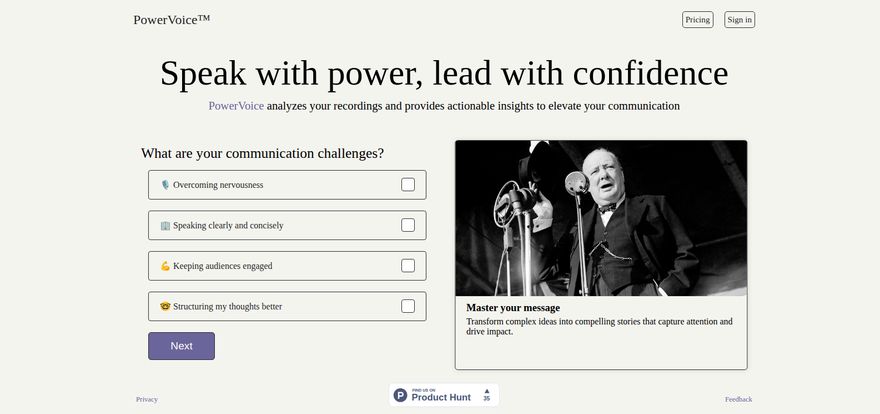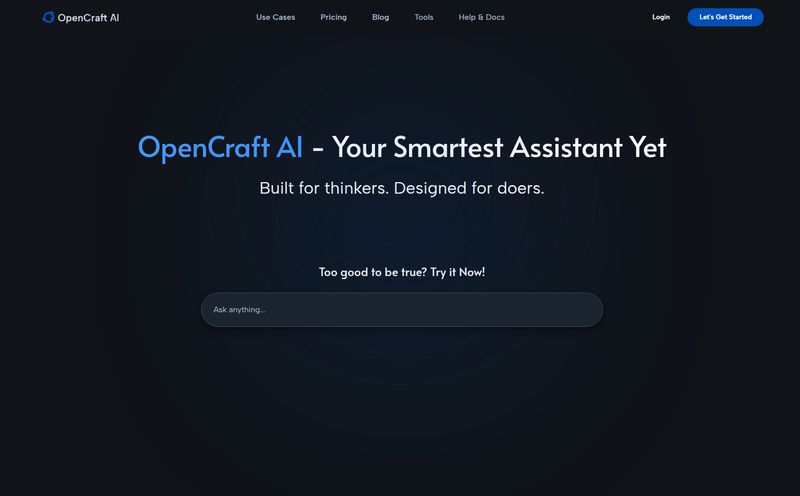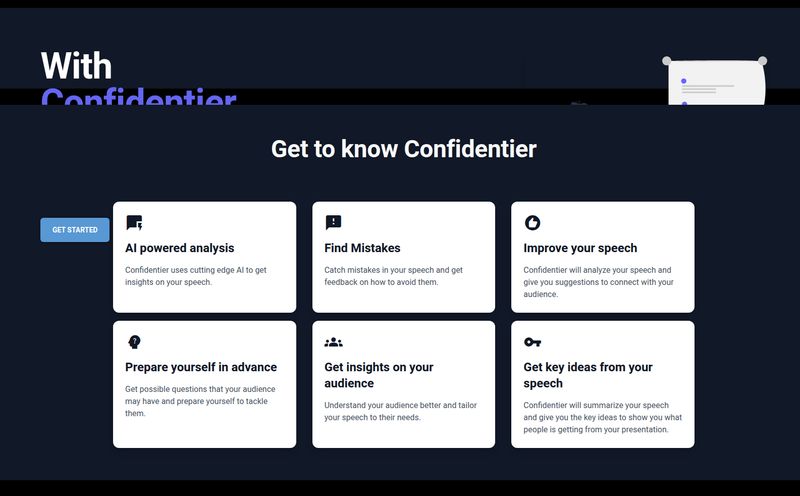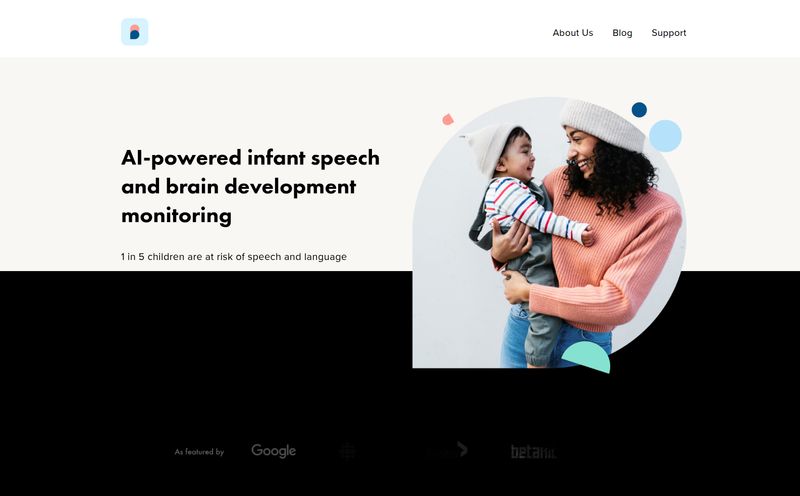Public speaking. For a lot of us, those two words are enough to make our palms sweat and our stomachs do a little flip-flop. I've been in the SEO and marketing game for years, presenting strategies to clients and speaking at small industry meetups, and I still get that jolt of adrenaline. You know the one. The fear of rambling, of losing your train of thought, or worse... boring your audience to tears.
We’ve all seen a presentation fall flat. It’s awkward for everyone. For decades, the only real solutions were to join a local Toastmasters club (shout out to them, they do great work!) or shell out some serious cash for a personal speech coach. Both are great options, but one requires a major time commitment and the other, a major budget.
But now, we're in this wild west of AI-powered everything. We have AI writing assistants, AI image generators... so it was only a matter of time before we got AI speech coaches. I recently stumbled upon a tool called PowerVoice, which claims it can analyze your speech and give you actionable insights to “speak with power, lead with confidence.”
My first thought? Skepticism. My second? Intense curiosity. An AI that can fix my tendency to use filler words when I'm nervous? Sign me up. So I took a closer look.
What is PowerVoice, Exactly?
Think of it like a flight simulator, but for your speeches. You record yourself speaking—maybe practicing a big presentation, a sales pitch, or even a wedding toast—and upload it. PowerVoice then crunches the data and acts as your digital coach, giving you feedback on where you can improve. It’s not about just correcting grammar; it's about elevating your entire delivery. Its designed to be a personal, data-driven training partner that lives right on your computer.
Breaking Down The Common Communication Hurdles
The PowerVoice homepage immediately got my attention because it listed the exact things that keep people up at night before a big talk. It’s almost like they read my diary.
Tackling Nervousness and Building Confidence
This is the big one, isn't it? The core fear. PowerVoice doesn’t have a magic wand to make your nerves disappear, but what it offers is practice. Repetition with feedback is the undisputed champion of confidence-building. The more you practice and see measurable improvement, the less daunting the real thing becomes. It helps you get out of your own head by focusing on specific, fixable things instead of that vague feeling of dread.

Visit PowerVoice
Speaking with Clarity and Precision
I have a bad habit of getting excited about a topic and then... my sentences just keep going. And going. An AI is brutally honest about things like that. It can help pinpoint where you started to ramble or where your message got muddled. This is invaluable for turning complex ideas into something your audience can actually digest and remember.
Keeping Your Audience Hooked
A monotone delivery is the assassin of engagement. While PowerVoice won't be measuring the facial expressions of a live audience, it can analyze your vocal variety—your pitch, pace, and volume. It gives you the data you need to avoid sounding robotic and instead sound like a passionate expert who actually cares about what they're saying.
Structuring Your Thoughts for Maximum Impact
A great speech has a clear beginning, middle, and end. It tells a story. The platform encourages you to structure your thoughts better, helping you see if your key points are landing or getting lost in the weeds. This is less about what you say and more about the flow and logic of how you say it.
My First Impressions and The Core Features
First off, it's important to know that PowerVoice is still in its early stages—the website mentions it's in Alpha. For me, that’s not necessarily a bad thing. It means the team is actively developing it, and early users often have a real chance to give feedback that shapes the tool's future. It also means you should expect a few quirks along the way, which is fair enough.
The core of the experience revolves around a few key features:
- AI-Powered Analysis: This is the engine of the whole thing. It listens to your tone, pacing, use of filler words (the dreaded 'ums' and 'ahs'), and probably a dozen other things I haven't even thought of.
- Personalized Feedback & Actionable Insights: This isn’t just a grade. It gives you specific notes. For example, it might tell you, “You spoke 20% faster in the second minute, which could indicate nervousness,” or “You used the word ‘basically’ 8 times.” That’s feedback you can actually use.
- Speaker Isolation: This is a pretty neat feature. It means you can record a conversation or a meeting and it will focus solely on your voice for the analysis. Super helpful if you’re practicing in a less-than-silent environment (hello, work-from-home parents).
Honestly, the whole concept feels like a grammar checker, but for your charisma. And as someone who relies on tools like Grammarly to catch my silly mistakes, the idea of having something similar for my speaking style is incredibly appealing.
Let's Talk Money: The PowerVoice Pricing
Okay, the all-important question: what does it cost? The pricing can sometimes be a barrier, but PowerVoice seems to be running a pretty aggressive promotion right now. Compared to hiring a human coach, which can easily run you several hundred dollars an hour, this is a completely different ballgame.
| Plan | Promotional Price | Original Price | Key Features |
|---|---|---|---|
| Basic | $9 / month | $39 | 20 Sessions/month, Personalized Feedback, Speaker Isolation |
| Standard (Most Popular) | $19 / month | $69 | 50 Sessions/month, Personalized Feedback, Speaker Isolation |
| Pro | $79 / month | $129 | 250 Sessions/month, Personalized Feedback |
Note: All tiers come with a 7-day free trial, so you can test it out before committing.
For someone who presents a few times a month, that Standard plan at $19 is a no-brainer to at least try. It’s the cost of a few fancy coffees. The testimonials on their site from Directors at Fortune 500 companies suggest that business professionals are already seeing the value, using it to dry-run important pitches. This isnt just a tool for students; its for anyone whose career depends on clear communication.
The Good and The... Room for Growth
What I Really Liked
The biggest win for me is the concept of actionable metrics. It's one thing to feel like you did better; it's another thing entirely to see a chart showing your filler words decreased from 10% to 2% over a week of practice. That's motivating. It gamifies self-improvement, turning a chore into a challenge. It gives you clear, objective goals to work towards, which is far more effective than just vaguely “trying to be better.”
A Few Things to Keep in Mind
Of course, it’s not perfect. The “Alpha” status means you’re an early adopter. And while the promotional pricing is great, the original pricing might be a bit steep for some, especially students or those just starting out. An AI also lacks the human touch of a real coach who can read your body language and offer encouragement based on emotional cues. This tool is a supplement, not a complete replacement for human interaction.
My Final Verdict
So, is PowerVoice worth it? In my opinion, yes. It's a genuinely innovative approach to a very old and very human problem. It makes speech coaching accessible and affordable in a way that just wasn't possible five years ago. It won't magically turn you into Winston Churchill overnight (as their homepage photo might suggest), but it gives you the tools to build that skill, brick by brick, with every recording.
If you're a professional who needs to pitch ideas, a team lead who runs meetings, or really, anyone who wants to feel more confident when they speak, PowerVoice is a fascinating and promising tool. The 7-day free trial makes it a risk-free experiment. You might just be surprised at what the data tells you.
Frequently Asked Questions
- Is PowerVoice good for beginners?
- Absolutely. In fact, it might be ideal for beginners. It provides a private, judgment-free space to practice and get foundational feedback without the pressure of a live audience or coach.
- How does the AI analysis actually work?
- It uses sophisticated speech recognition and machine learning models to analyze various aspects of your speech. It transcribes your words to check for fillers and repetition, and analyzes the audio waveform itself to assess pace, tone, and volume changes.
- Can I use PowerVoice for everyday conversations?
- While it's designed for presentations and speeches, you could certainly use it to analyze your conversational patterns, such as in a mock interview. The insights on clarity and filler words are universal.
- Is there a free trial for PowerVoice?
- Yes, according to their pricing page, all plans come with a 7-day free trial so you can test the features and see if it’s a good fit for you before paying.
- What is "Speaker Isolation"?
- Speaker Isolation is a feature that allows the AI to focus only on your voice, even if there's background noise or other people talking in the recording. This is great for getting accurate feedback from recordings of real meetings or busy environments.
- Is my data private when I upload recordings?
- This is a critical question for any AI tool. While I don't have their specific privacy policy in front of me, any reputable company in this space should use secure, encrypted connections and have clear policies about data usage. I would always recommend reviewing the privacy policy on their website before uploading sensitive material.
Reference and Sources
- PowerVoice Official Website
- PowerVoice Pricing Page
- PowerVoice on Product Hunt
- Toastmasters International - A great resource for in-person public speaking practice.



